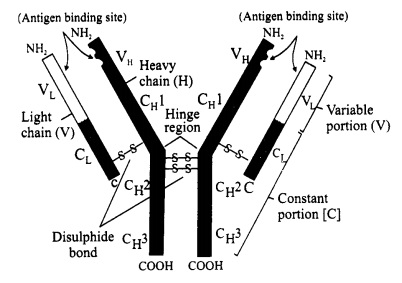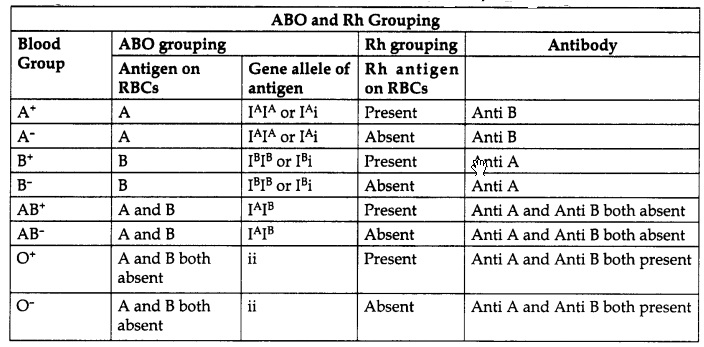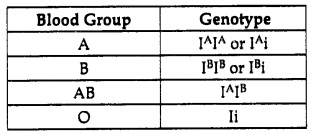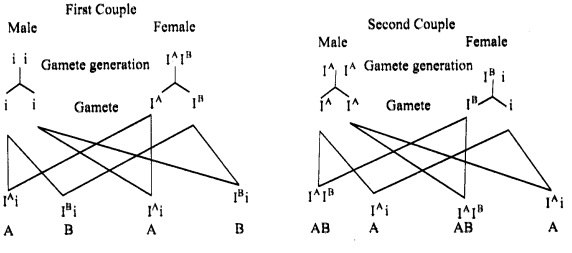Rajasthan Board RBSE Class 10 Science Notes Chapter 4 Immunity and Blood Groups
- Immunity: The ability of our body to fight with diseases is called immunity.
- Immunology: The branch of science which deals with the system and functions in body to fight with germs is called immunology. Numerous lymphocytes, lymph, blood, liver, bone marrow and thymus are always busy in providing immunity to the body.
There are two types of immunity in the body:
A. Innate Immunity or Innate Defence Mechanism:
This type of immunity is inborn. This is also called general or natural immunity. This type of immunity does not give any special protection against any specific germ rather works against all the antigens in the same way. Hence, it is called general immunity. Following factors facilitate working of innate immunity:
- Physical Barriers: Physical barriers prevent the entry of germs physically. For example; skin and cilia in many organs.
- Chemical Barriers: Some germs are warded off by means of chemical barriers. For example; hydrochloric acid in stomach kills any germ in food.
- Cellular Barriers: Many special cells eat away germs, e.g. macrophages, neutrophils, etc.
- Inflammation: Inflammation and fever also work against germ. The high temperature during fever and inflammation kills the germs.
B. Acquired Immunity or Acquired Defence Mechanism:
This type of immunity is acquired by the body in response to a specific germ and learns to fight that antigen. It remembers and can fight any future onslaught of a specific germ. There are two types of acquired immunity which are as follows:
- Active Immunity: When body proactively prepares an antibody against a specific antigen.
- Passive Immunity: In this case, the body does not make any antibody. The antibody is specially inoculated in the body from outside e.g. vaccination against tetanus.
RBSE Class 10 Science Chapter 4 Notes Antigen:
The germ or foreign material which enters the body and converts B-lymphocytes into antibody producing plasma cells and specifically interacts with that antibody is called an antigen. It is also called immunoglobin.
Antigens are generally those external substances which have molecular weight more than 6000 Dalton. Sometimes, antigens can be produced inside the body, e.g. in case of viral infection or by cancerous cells.
Antigenic Determinant:
The whole molecule of antigen does not interact with antibody rather some specific parts interact with antibody. These parts are called antigenic determinant or epitope.
Immunity And Blood Group Class 10 RBSE Notes Valency of Antigen:
A chain of about 6 to 8 amino acids in a protein work as antigenic determinant. Number of antigenic determinant in a protein is called the valency of antigen. In most of the bacteria, the antigenic valency can be 100 or even more.
Four steps of destruction of antigen:
- Differentiation between internal and external antigens.
- Formation of plasma cells by B-lymphocyte cells according to the antigenic determinant present on external antigen.
- Formation of specific antibodies by plasma cells.
- Destruction of antigen by antigen-antibody reaction and by cell mediated immunity (CMI).
Immunity And Blood Group Class 10 Antibody:
The protein which is produced by B-lymphocytes in response to an antigen and can specifically interact with the antigen. This interaction depends on specific structure of antigen and is at the root of immune system. The part of antibody which reacts with antigen is called paratope.
Antibody is in the shape of Y and is made up of 4 structural units two heavier units (H) and two lighter units (L).
A heavier and a lighter chain make a HL dimer by disulphide bond. The H and L chains in each half are also joined together by disulphide bond

Each heavier and lighter chain is divided into two parts:
- Variable Portion: This part reacts with antigen and is present towards NH2 part of the chain. This is also called Fab portion.
- Constant Portion: This part is towards COOH part of the chain and is called Fc portion.
In most of the antigen, the arms of Y-shape have flexible origins which are called hinge. Due to flexibility of hinge, the variable portion is able react with molecules in antigen.
| Types of Antibodies | ||
| Type | Polypeptide chain present | Special comment |
| IgG | Gamma (Υ) | Has maximum concentration in serum. Is only antibody which can cross placenta and reach the embryo. |
| IgM | Mu (μ) | Is pentameric structure and is the first antibody produced after reaction with antigen. |
| IgA | Alpha (α) | Is only antibody present in mother’s milk. |
| IgE | Epsilon (ε) | Mainly acts on basophils and mast cells and participates in allergic reactions. |
| IgD | Delta (δ) | Signal the B cells to be activated for defence of the body. |
Immunity And Blood Groups Class 10 In Hindi Blood:
Blood is a fluid tissue which is composed of plasma and blood cells. There are three types of blood corpuscles which are as follows:
- Red Blood Corpuscles or Red Blood Cells: They facilitate transport and exchange of gases.
- White Blood Corpuscles or White Blood Cells: They protect the body from germs.
- Platelets: They are responsible for coagulation of blood.
Blood Groups:
Blood is divided into four groups on the basis of presence of antigen on the surface of RBCs. These antigens can generally be protein, glycoprotein, carbohydrate or glycolipid. These antigens come from one allele of a gene and are transmitted genetically from parents to children.

Rh Factor:
This factor is a protein which is composed of about 417 amino acids. There are five types of Rh factor in humans, viz. Rh D, Rh E, Rh e, Rh C, and Rh c. The most important Rh factor is Rh D because it is the most immunogenic.
RBSE Solutions For Class 10 Science Chapter 4 Rh Incompatibility:
If Rh positive blood is transfused to an Rh negative person then recipient’s body produces IgG antibodies. These antibodies destroy RBCs by agglutination. As a result, the person dies due to renal failure.
Erythroblastosis Foetalis:
During the first pregnancy of Rh negative mother with Rh positive child, the mother’s body develops IgG antibodies because mother’s blood gets mixed up with foetal blood during child birth. The birth of the first child is normal. Complications develop if the second child is also Rh positive. The Rh antibodies in mother’s blood react with Rh factor in foetal blood. This results in destruction of RBCs in foetus and may result in death of the child or the child is very weak and suffers from hepatitis. This condition is called erythroblastosis foetalis. To prevent this, the mother is given a vaccine of anti IgG antibody (anti Rh. D) within 24 hours of birth of the first child. These are called Rhogam antibodies.
Immunity And Blood Group Class 10 RBSE Blood Transfusion:
The method to transfer blood from one person to another’s circulatory system is called blood transfusion.
Requirement of Blood Transfusion:
- In case of accident and excess bleeding.
- Severe shortage of blood in body.
- During a surgery.
- Low platelet count in blood.
- Patient of hemophilia.
- Patient of sickle cell anemia.
Process of Blood Transfusion: It is divided into two parts:
A. Blood Collection:
- Thorough health checkup of donor.
- Blood is collected in sterilized anticoagulant containing pouch with the help of a cannula.
- Collected blood is stored at low temperature.
- Blood is checked for any infection; like hepatitis, HIV, etc. and is also checked for ABO grouping and Rh factor.
RBSE Class 10 Science Chapter 4 B. Blood Transfusion:
- Donor’s blood is matched with recipient 7s blood for ABO grouping and Rh factor.
- Stored blood is taken out of refrigerator about 30 minutes before actual transfusion.
- Blood transfused intravenously and the process takes about 4 hours.
- The recipient is continuously monitored for any untoward reaction.
Based on the source of blood, there are two types of blood transfusion:
- Allogenic Transfusion: When blood from another person is used for transfusion.
- Autogenic Transfusion: When self blood is used for transfusion.
Components of blood can also be separated before transfusion so that different components can be utilized separately as per need.
Significance of Blood Group Heredity:
The following table shows the genotype of different blood groups:

Blood group in the child obeys Mendel’s laws of inheritance. Inheritance of blood groups has many uses, like in settling disputes related to parentage of a child, in blood transfusion, in treating

The diagram shows possible blood groups in child from each couple
RBSE Solution Class 10 Science Chapter 4 Organ Donation and Body Donation:
Organs from a live donor or from a dead donor can be successfully transplanted in a needy patient.
A live donor can donate kidney, liver and bone marrow, Many organs can be used for transplantation from a dead body.
Organs of a brain dead person can be harvested for transplantation. Now-a-days, organs from road accident victims are utilized for this purpose. For this, consent of the dead person’s relatives is mandatory.
In our country, there is a huge waiting list of patients who need organs from donors. But this demand is only partially fulfilled. Government and many NGOs are carrying out sustained campaigns to increase awareness about organ donation.